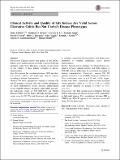| dc.contributor.author | Taleban, Sasha | |
| dc.contributor.author | Singh, Prashant | |
| dc.contributor.author | Yajnik, Vijay | |
| dc.contributor.author | Khalili, Hamed | |
| dc.contributor.author | Stewart, Kathleen O. | |
| dc.contributor.author | Li, Darrick K. | |
| dc.contributor.author | Pardi, Darrell S. | |
| dc.contributor.author | Sturgeon, Holly C. | |
| dc.contributor.author | Ananthakrishnan, Ashwin N. | |
| dc.contributor.author | Xavier, Ramnik Joseph | |
| dc.date.accessioned | 2017-03-16T23:01:47Z | |
| dc.date.available | 2017-03-16T23:01:47Z | |
| dc.date.issued | 2016-05 | |
| dc.date.submitted | 2016-02 | |
| dc.identifier.issn | 0163-2116 | |
| dc.identifier.issn | 1573-2568 | |
| dc.identifier.uri | http://hdl.handle.net/1721.1/107455 | |
| dc.description.abstract | Background
Clinical activity and quality of life (QOL) indices assess disease activity in Crohn’s disease (CD) and ulcerative colitis (UC). However, a paucity of data exists on the validity of these indices according to disease characteristics.
Aims
To examine the correlation between QOL and clinical activity indices and endoscopic disease activity according to disease characteristics.
Methods
We used a prospective registry to identify CD and UC patients ≥18 years old with available information on Short Inflammatory Bowel Disease Questionnaire scores (SIBDQ), Harvey–Bradshaw Index (HBI) and simple endoscopic scores for CD (SES-CD), and Simple Clinical Colitis Activity Index (SCCAI) and Mayo endoscopic score for UC. We used Spearman rank correlations to calculate correlations between indices and Fisher transformation to compare correlations across disease characteristics.
Results
Among 282 CD patients, we observed poor correlation between clinical activity and QOL indices to SES-CD with no differences in correlation according to disease characteristics. Conversely, among 226 UC patients, clinical activity and QOL had good correlation to Mayo endoscopic score (r = 0.55 and −0.56, respectively) with better correlations observed with left-sided versus extensive colitis (r = 0.73 vs. 0.45, p = 0.005) and shorter duration of disease (r = 0.61 vs. 0.37, p = 0.04).
Conclusions
Our data suggest good correlation between SCCAI and endoscopic disease activity in UC, particularly in left-sided disease. Poor correlations between HBI or SIBDQ and SES-CD appear to be consistent across different disease phenotypes. | en_US |
| dc.description.sponsorship | American Gastroenterological Association | en_US |
| dc.publisher | Springer US | en_US |
| dc.relation.isversionof | http://dx.doi.org/10.1007/s10620-016-4180-8 | en_US |
| dc.rights | Article is made available in accordance with the publisher's policy and may be subject to US copyright law. Please refer to the publisher's site for terms of use. | en_US |
| dc.source | Springer US | en_US |
| dc.title | Clinical Activity and Quality of Life Indices Are Valid Across Ulcerative Colitis But Not Crohn’s Disease Phenotypes | en_US |
| dc.type | Article | en_US |
| dc.identifier.citation | Taleban, Sasha, Kathleen O. Stewart, Darrick K. Li, Prashant Singh, Darrell S. Pardi, Holly C. Sturgeon, Vijay Yajnik, Ramnik J. Xavier, Ashwin N. Ananthakrishnan, and Hamed Khalili. “Clinical Activity and Quality of Life Indices Are Valid Across Ulcerative Colitis But Not Crohn’s Disease Phenotypes.” Digestive Diseases and Sciences 61, no. 9 (May 3, 2016): 2627–2635. | en_US |
| dc.contributor.department | Institute for Medical Engineering and Science | en_US |
| dc.contributor.mitauthor | Xavier, Ramnik Joseph | |
| dc.relation.journal | Digestive Diseases and Sciences | en_US |
| dc.eprint.version | Author's final manuscript | en_US |
| dc.type.uri | http://purl.org/eprint/type/JournalArticle | en_US |
| eprint.status | http://purl.org/eprint/status/PeerReviewed | en_US |
| dc.date.updated | 2017-02-02T15:21:16Z | |
| dc.language.rfc3066 | en | |
| dc.rights.holder | Springer Science+Business Media New York | |
| dspace.orderedauthors | Taleban, Sasha; Stewart, Kathleen O.; Li, Darrick K.; Singh, Prashant; Pardi, Darrell S.; Sturgeon, Holly C.; Yajnik, Vijay; Xavier, Ramnik J.; Ananthakrishnan, Ashwin N.; Khalili, Hamed | en_US |
| dspace.embargo.terms | N | en |
| mit.license | PUBLISHER_POLICY | en_US |
